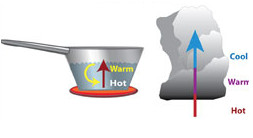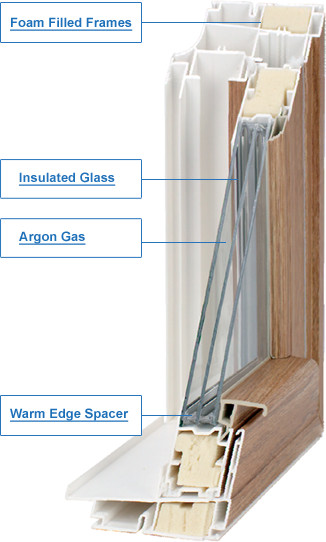Winter Heat LossTM
Heat transfer always occurs from a higher temperature object to a cooler temperature object. In the winter, heat usually travels from the inside of your house to the outdoors. Winter Heat Loss (scientists call it U-factor) measures this heat transfer which is primarily caused by conduction and convection.
Conduction
Energy is transferred through direct contact.

Our Defense Against Conduction
Insulated Glass almost eliminates the connection between the inside of your home and outside at the glass - no connections, no convection.
Foam Filled Frames insulates the connection point between the inside and outside of your home at the frame - insulated connection reduces convection.
Warm Edge Spacer at the edge of the glass lessens the connection point by its U-shaped design as opposed to a square shaped design - less connection, less convection.
Convection
Energy is transferred through air, gas or liquid.

Our Defense Against Convection
Argon Gas between the panes of glass. Argon is slower-moving than air and thus minimizes convection currents within this air space.

Winter Heat Loss Numbers
The Insulation Value number represents how much heat is transferred through your entire window. So a lower number is better. An Insulation Value of 1 is roughly what a single pane window receives. Add dual pane glass and that number will come down about 50% to roughly .50, add a low-e coating and the Insulation Value will come down roughly another 30% to about a .35. Adding multiple layers of low-e coating and low-e coating and argon gas will bring it down to .30 and below based on the quality of the window frame and glass. Beware of window companies that measure the center of the glass. These numbers will be lower but you are not buying just the center of the glass, you are buying an entire window. Our numbers represent the entire window.

What about R-factors (or R-values)?
Some people are familiar with R-factors. R-factors measure heat resistance; so the higher the R-factor the better. Winter Heat Loss (U-factor) measures heat transference; so the lower the U-factor the better. Wall and ceiling insulation is measured by heat resistance - R-factors. The EPA has required windows and doors to be measured by heat transference - U-factor. The inverse of heat transfer (U-factor) is heat resistance (R-factor). So 1 divided by the U-factor is the R-factor. One divided by .28 equates to a 3.57 R-factor.

 317-353-3000
317-353-3000



